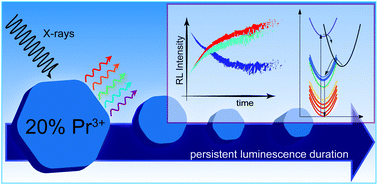On a local (de-)trapping model for highly doped Pr3+ radioluminescent and persistent luminescent nanoparticles†
Abstract
Trivalent praseodymium exhibits a wide range of luminescent phenomena when doped into a variety of different materials. Herein, radioluminescent NaLuF4:20%Pr3+ nanoparticles are studied. Four different samples of this composition were prepared ranging from 400–70 nm in size. Kinetic studies of radioluminescence as a function of X-ray irradiation time revealed a decrease in the emissions originating from the 1S0 level, due to the formation or optical activation of defects during excitation, and a simultaneous increase in the visible emissions resulting from the lower optical levels. Thermoluminescence measurements elucidated that a local de-trapping mechanism was responsible for the increase in steady state emission and persistent luminescence originating from the lower optical levels. The results and mechanism described through this study serve to provide a novel nanoparticle composition with versatile luminescent properties and provides experimental evidence in favor of a local trapping model.



 Please wait while we load your content...
Please wait while we load your content...